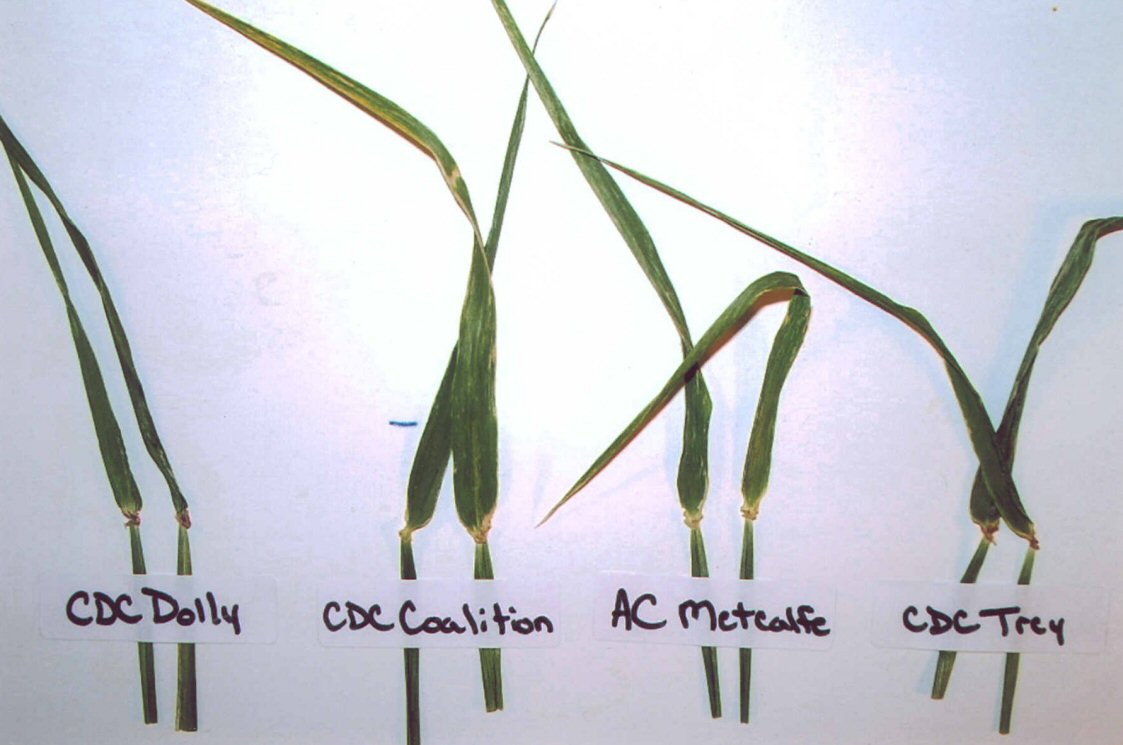CDC Coalition
| Denomination: | 'CDC Coalition' |
|---|---|
| Previously Proposed Denomination: | 'TR03373' |
| Botanical Name: | Hordeum vulgare |
| Applicant/Holder: |
University of Saskatchewan Crop Development Centre 4D36 Agriculture Building, 51 Campus Drive Saskatoon, Saskatchewan S7N 5A8 Canada |
| Breeder: |
Brian Rossnagel, University of Saskatchewan, Saskatoon, Saskatchewan |
| Application Date: | 2006-03-28 |
| Application Number: | 06-5394 |
| Grant of Rights Date: | 2008-10-30 |
| Certificate Number: | 3384 |
| Grant of Rights Termination Date: | 2026-10-30 |
Variety Description
Varieties used for comparison: 'CDC Dolly', 'AC Metcalfe' and 'CDC Trey'
Summary: The flag leaf of 'CDC Coalition' has stronger pubescence and weaker anthocyanin colouration of the auricles than that of 'CDC Dolly'. Anthocyanin colouration on the tips of the lemma awns is weak to moderate for 'CDC Coalition' while it is strong for 'CDC Dolly' and moderate to strong for 'CDC Trey'. 'CDC Coalition' has a shorter spike length (excluding awns) and weaker curvature of the first segment of the rachis than 'CDC Trey'. 'CDC Coalition' has taller plants (including spikes and awns) than 'CDC Dolly' and shorter plants than 'CDC Trey' and 'AC Metcalfe'. Anthocyanin colouration of the nerves of the lemma on the kernel is moderate to strong for 'CDC Coalition' while it is absent to very weak for 'AC Metcalfe'. The rachilla hair on the kernel is long for 'CDC Coalition' while it is short for 'CDC Dolly' and 'CDC Trey'.
Description:
YOUNG PLANT: erect growth habit, green coleoptile
PLANT: absent or very sparse pubescence on the sheath of lower leaves, semi-erect to intermediate growth habit, approximately 1/4 of plants with recurved flag leaf
FLAG LEAF BLADE: medium to dense pubescence
FLAG LEAF SHEATH: strong glaucosity, absent to sparse pubescence
FLAG LEAF AURICLE: weak to moderate anthocyanin colouration, sparse pubescence on margins
SPIKE: mid-season emergence, platform and cup shaped collar, erect to semi-erect attitude, medium to strong glaucosity, parallel shape, dense, awns longer than spike, parallel to weakly divergent attitude of sterile spikelet, relative length of glume and awn of median spikelet is equal to grain
FIRST SEGMENT OF RACHIS: short to medium length, weak curvature
LEMMA AWNS: weak to moderate anthocyanin colouration on tips, rough barbs on margins
KERNEL: medium to strong anthocyanin colouration of nerves of lemma, whitish aleurone layer, husk present, long rachilla hair, medium spiculation of inner lateral nerves on dorsal side of lemma, no hairiness of ventral furrow, clasping lodicules, incomplete horseshoe shaped basal markings, long length, medium to broad width
DISEASE RESISTANCE: susceptible to very susceptible to Spot blotch (Cochliobolus sativus) and Scald (Rhynchosporium secalis), susceptible to Barley yellow dwarf virus, moderately susceptible to susceptible to Fusarium head blight (Scab) (Fusarium graminearum; perfect state Gibberella zeae), moderately resistant to moderately susceptible to Common root rot (Cochliobolus sativus, Fusarium spp.) and Net blotch (Pyrenophora teres), moderately resistant to Stem rust (Puccinia graminis) and Covered smut (Ustilago hordei), resistant to False loose smut/Black semi-loose smut (Ustilago nigra) and True loose smut (Ustilago nuda)
AGRONOMY: good lodging resistance, good shattering resistance, good tolerance to straw breaking, good tolerance to neck breaking, fair to good tolerance to drought
Origin & Breeding History: 'CDC Coalition' (experimental designations 'SB01145' and 'TR03373') was developed by the Crop Development Centre's (CDC) barley breeding program at the University of Saskatchewan in Saskatoon, Saskatchewan. A pedigree breeding system was used. It originated from the cross between 'TR251' and 'Baronesse' made in 1997. The F1 through F4 generations were grown as bulk populations with the F1 and F3 grown in winter nurseries in New Zealand. 'CDC Coalition' was grown and selected as a single F4 derived F5 hill plot in Saskatoon in 2000. The seed from the F5 was bulked as the line that became 'CDC Coalition'. It was tested in CDC yield trials in 2001 and 2002 followed by testing in the Western Canadian 2-Row Cooperative trials during 2003 and 2004. Selection criteria for 'CDC Coalition' included high yield potential, straw strength, disease resistance and grain quality.
Tests & Trials: Tests and trials for 'CDC Coalition' were conducted during 2005 and 2006 in Saskatoon, Saskatchewan. The trial consisted of 3 x 3.7 metre rows per variety planted in a randomized complete block design which was replicated twice. The data in the comparative table are from the test and trials conducted in 2006 only.
Comparison tables for 'CDC Coalition' with reference varieties 'CDC Dolly', 'AC Metcalfe' and 'CDC Trey'
Spike length (excluding awns) (cm)
| 'CDC Coalition' | 'CDC Dolly' | 'AC Metcalfe' | 'CDC Trey' | |
|---|---|---|---|---|
| mean | 7.00 | 7.20 | 6.88 | 7.75 |
| std. deviation | 0.54 | 0.64 | 0.51 | 0.50 |
Plant height (stem plus spike, including awns) (cm)
| 'CDC Coalition' | 'CDC Dolly' | 'AC Metcalfe' | 'CDC Trey' | |
|---|---|---|---|---|
| mean | 68.65 | 64.75 | 72.60 | 79.95 |
| std. deviation | 3.34 | 3.42 | 3.15 | 2.26 |
Click on image for larger view

Barley: 'CDC Coalition' (left) with reference varieties 'CDC Dolly' (center left), 'AC Metcalfe' (center right) and 'CDC Trey' (right)
Click on image for larger view

Barley: 'CDC Coalition' (center left) with reference varieties 'CDC Dolly' (left), 'AC Metcalfe' (center right) and 'CDC Trey' (right)
- Date modified: